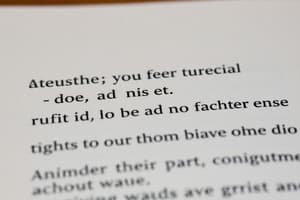Podcast
Questions and Answers
Adverbs of manner describe when an action takes place.
Adverbs of manner describe when an action takes place.
False (B)
Adverbs of time come after the main predicate of a sentence.
Adverbs of time come after the main predicate of a sentence.
True (A)
Degree adverbs show the extent to which something happens.
Degree adverbs show the extent to which something happens.
True (A)
Adverbs can only modify verbs in a sentence.
Adverbs can only modify verbs in a sentence.
Adverbs of manner modify adverbs in a sentence.
Adverbs of manner modify adverbs in a sentence.
Adverbs of degree always come after the base form of the verb they modify.
Adverbs of degree always come after the base form of the verb they modify.
Adverbs of time indicate how an action is performed.
Adverbs of time indicate how an action is performed.
Degree adverbs can modify prepositions in a sentence.
Degree adverbs can modify prepositions in a sentence.
Adverbs of manner describe the extent to which an action happens.
Adverbs of manner describe the extent to which an action happens.
Adverbs are commonly used to modify adjectives in everyday writing.
Adverbs are commonly used to modify adjectives in everyday writing.
Study Notes
An adverb is a word that modifies a verb, noun, pronoun, or other adjective or adverb by giving more information about how something happened or what kind of action was taken. There are several different types of adverbs based on their function within sentences, including:
-
Adverbs of manner describe how an action is performed, such as quickly, loudly, gracefully, etc. These can modify verbs or even entire clauses. For example, John played his guitar beautifully.
-
Adverbs of time indicate when an action takes place, like yesterday, tomorrow, often, sometimes, always, rarely, etc. They typically come after the main predicate of a sentence. For instance, He usually plays video games every Saturday afternoon.
-
Adverbs of degree show the extent to which something happens, using degrees of comparison (e.g., he's very good at playing chess) or intensifiers (he's incredibly smart). Degree adverbs generally come before the base form of the verb they modify. Examples include quite, too, extremely, completely, partially, nearly, hardly ever, seldom.
Adverbs can also be used to modify prepositions, adjectives, or other adverbs, although this usage isn't common in everyday writing because it doesn't convey any additional meaning beyond what already exists from context. However, these types exist nonetheless and could potentially appear in formal or technical writings:
- Adverbs of frequency tell us how often an action occurs, with various terms like daily, weekly, monthly, yearly, continuously, occasionally, periodically, regularly, irregularly, temporarily, permanently, intermittently, alternately, sequentially, randomly, unpredictably. Such modifiers typically go between the subject and object of the clause being modified.
In summary, there are multiple ways to express ideas through adverbs depending on their role in the sentence; each type conveys specific pieces of information that help shape our understanding of events, actions, states of affairs, and more. By incorporating different types of adverbs into your writing, you can make your descriptions clearer, more vivid, and easier to understand.
Studying That Suits You
Use AI to generate personalized quizzes and flashcards to suit your learning preferences.
Description
Learn about the various types of adverbs and how they function within sentences, including adverbs of manner, time, degree, and frequency. Understand how adverbs modify verbs, nouns, pronouns, adjectives, and other adverbs to provide more detailed information about actions, events, and states.




